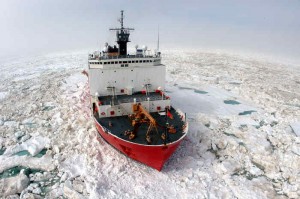
Race for Arctic Energy Resources Shows Need for U.S. to Ratify Law of the Sea Treaty
–Cross-Posted from Andrew Holland’s Energy, Security, Policy blog-
As I have been researching and writing about Arctic energy development recently, there’s one important – and easy – policy prescription that often comes up: joining the UN Convention on the Law of the Sea (UNCLOS). As I mentioned in my article, “Energy Development in the Arctic: Threats and Opportunities” the USGS estimates that the Arctic region has 22% of the world’s undiscovered energy resources – and 84% of those resources are expected to occur offshore (so 18.5% of the undiscovered resources are on or under the Arctic seabed).
 In the Arctic Sea, where there has been very little economic, social, or military activity, borders are not clearly defined and tested by international law. That is changing swiftly, as Shell prepares to move significant personnel and drilling equipment to the Chukchi and Beaufort Seas north of Alaska this summer for the first time. Other countries to are joining a “Race for the Arctic“ as countries and companies seek access to newly available oil and gas. As countries compete for these resources, the U.S. needs to become a party to the UN Convention on the Law of the Sea in order to define American exclusive rights.
In the Arctic Sea, where there has been very little economic, social, or military activity, borders are not clearly defined and tested by international law. That is changing swiftly, as Shell prepares to move significant personnel and drilling equipment to the Chukchi and Beaufort Seas north of Alaska this summer for the first time. Other countries to are joining a “Race for the Arctic“ as countries and companies seek access to newly available oil and gas. As countries compete for these resources, the U.S. needs to become a party to the UN Convention on the Law of the Sea in order to define American exclusive rights.
Under customary maritime law, the U.S. has access to its exclusive economic zone (EEZ) out to 200 nautical miles from shore. That means that the U.S. can allow, regulate, tax, or prohibit any economic activity in this area. The most obvious economic activities are offshore drilling and fishing. The EEZ is different from territorial waters in that the EEZ is considered international waters, but territorial waters — through which states must still allow ‘innocent passage’ of ships — are considered fully part of sovereign territory.
Under UNCLOS, the EEZ for resources on or under the seabed can be extended a further 150 nautical miles (for a total of 350 nautical miles from shore) if it can be proved that the continental shelf extends that far.
In the Arctic, all the other littoral states — Canada, Denmark (for Greenland), Norway, Iceland, and Russia — have put their claim for extended seabed EEZs into the UNCLOS secretariat for the purposes of claiming the seabed rights to the undiscovered resources, but because the U.S. is not a party to UNCLOS, the U.S. has not submitted any claim. The map, provided in the IISS’ (my former employer) 2012 Military Balance, shows how some of those claims overlap. Because the U.S. has not ratified the Convention, American diplomats are not at the table when those territorial claims are arbitrated.
This past Wednesday, I attended a forum hosted by the Pew Charitable Trusts and the Atlantic Council which brought together some of the nation’s most important business and national security leaders to call for a ratification of the Law of the Sea. Secretary of Defense Panetta and Chairman of the Joint Chiefs Dempsey, former Senators Lott, Warner, and Hagel, and former Director of National Intelligence Negroponte all expressed their strong support for passage of the treaty. Pew has founded a group called the American Sovereignty Campaign (www.ratifythetreatynow.org) to call for a ratification of the UNCLOS in the Senate. Not surprisingly, two of the most supportive Senators are Alaska’s Senators Begich and Murkowski.
Ratification of the Law of the Sea Treaty is a tool to expand and confirm American sovereignty without resorting to military force. The Arctic Ocean is the region in which American sovereignty is most in doubt. The Navy and Coast Guard can unilaterally protect and extend American sovereignty in that region, but joining the UNCLOS would be a better way to confirm that sovereignty in law.






[…] Holland: Race for Arctic Energy Resources Shows Need for U.S. to Ratify Law of the Sea Treaty […]